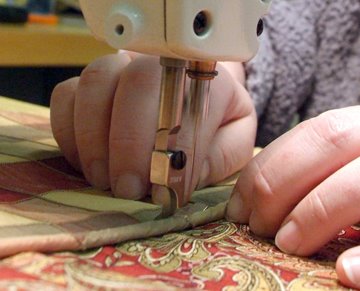Who wants to be a glutton anyway? I mean, really, you don't want to be perceived person with the loaded plate leaving the buffet line? Or the gorger basking with pride at the disgustingness of an "I.used.every.topping.they.offered" explosion at the make your own sundae event.
In short, don't treat the decorating process like a buffet - grabbing whatever is in front of you just because it is there. Instead, think ahead as you would in preparing a fine multiple-course meal.
As outlined by our good friend, Wikipedia, "In formal dining, a full course dinner can consist of five, seven, eight, ten or twelve courses, and, in its extreme form, has been known to have twenty-one courses. In these more formalized dining events, the courses are carefully planned to complement each other."
Good design is similar in principle. It takes time and planning, so each space, item, furnishing, fabric, etc., is carefully planned to complement each other. Good design is much more savory when ideas are allowed to simmer!
The thought of creating a master design plan for you home, can be as overwhelming as standing at the buffet. You find yourself thinking, "how on earth am I supposed to make the "right" choice?" You can call in the troops at that point - your designer or decorator - or you can continue to battle through on your own.
We get it. You want to get it right, but you are living by portion control. That's ok. A good design plan can be worked on in phases. The biggest point to remember: PLAN. As you put all your creative genious to task - or your designers' creative genius - planning will assure you don't end up with a "my eyes were bigger than my stomach" belly ache, because you hastily purchased a bunch of knick knacks, chatskis, photos, pillows, paint colors, etc., all without a single thread of unity.
If you are going it alone, and not ready to call in help, here are a few tips to get you started in an organized and manageable way.
Take some measurements! Having accurate measures of every window and room size in your home is essential for creating floor plans and purchasings blinds, shades and window treatments.
Prioritize the necessities vs. the desired, so you know which items get on the buy list first.
Set a realistic financial plan for yourself. What do you have available to spend? What do you need to save for? This is going to require some research so you know what it costs to buy QUALITY furnishings, which will allow you to budget accordingly.
Create color reference cards for artwork or pre-existing items you have in your home that you'll need to work with. Best way to do this, is to match paint samples to the art and keep these in a reference document.
Collect inspiration images, whether in hard-copy, electronic or online, that capture the feeling that you want to create in your home. Many times it's difficult for people to define their style. If you begin collecting images as you see them, after some time you will likely begin to notice patterns emerge; your style, through what you've collected, will begin to reveal itself. Perhaps you want a Beach House vibe?
Hopefully, working on these five-steps will set you in motion for well-balanced design decisions that meet your short AND long-term goals!
Tell me, in the comments below, how this post has helped you to think about your projects differently and what area of your home you plan to tackle next!




























No comments:
Post a Comment
Did I ever tell you how much I love your comments? I really do love hearing your thoughts after reading posts? Lets me know people are reading and helps us keep the conversation going!! ~ Thank you!